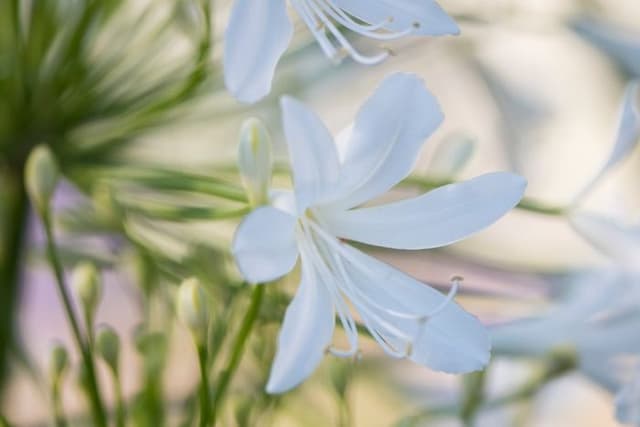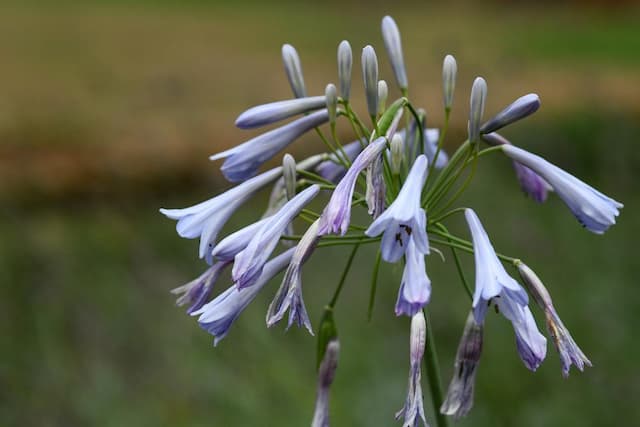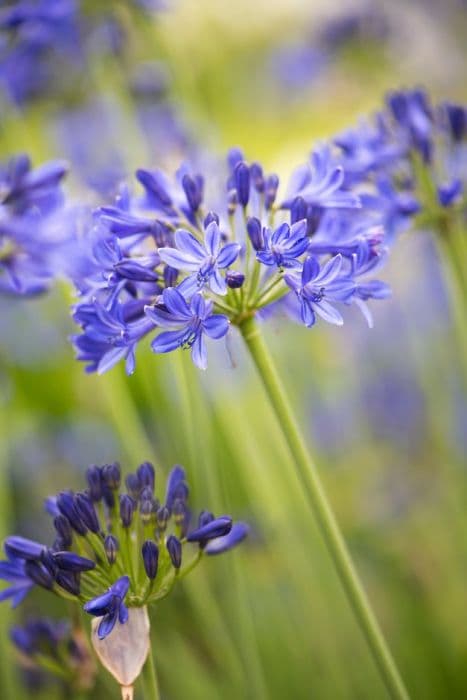African Lily Agapanthus 'Purple Cloud'

ABOUT
Agapanthus 'Purple Cloud' is a striking plant known for its lush, strap-like leaves that are a deep green hue, providing a rich backdrop for the blooms. The leaves create a dense, fountain-like clump, showcasing a decidedly tropical appearance. The showstopper of this plant, however, is its magnificent flowers. The blooms rise above the foliage on tall, sturdy stalks that culminate in a spherical cluster, known as an umbel. Each umbel is composed of numerous individual trumpet-shaped flowers. These blossoms are a captivating deep purple or violet, sometimes appearing so rich in color they could be mistaken for a dark storm cloud hence the name 'Purple Cloud'. The contrast between the verdant foliage and the intense purple flowers makes this plant a dramatic and appealing addition to any garden display. Each flower is delicate and made up of six petals that fan outwards from a central point, creating a star-like pattern when viewed from above. The overall effect of the Agapanthus 'Purple Cloud' is one of regal beauty and elegance, with the blooming period being particularly eye-catching when the flowers are at their peak.
About this plant
 Names
NamesFamily
Amaryllidaceae
Synonyms
African Lily, Lily of the Nile, Love Flower
Common names
Agapanthus 'Purple Cloud'.
 Toxicity
ToxicityTo humans
The Agapanthus, also known as Lily of the Nile, is not highly toxic to humans, but it does contain compounds that can cause illness if ingested. Symptoms of poisoning from consuming parts of the Agapanthus may include nausea, vomiting, and diarrhea. In some cases, skin contact with the sap can cause irritation or dermatitis. It is advisable to handle the plant with care and prevent children from ingesting any part of it.
To pets
The Agapanthus or Lily of the Nile is considered toxic to pets, especially cats and dogs. If a pet ingests any part of the plant, symptoms of poisoning can include vomiting, diarrhea, abdominal pain, and in severe cases, tremors or cardiac issues. Pet owners should keep their pets away from the plant and seek veterinary advice if they suspect their pet has consumed any part of it.
 Characteristics
CharacteristicsLife cycle
Perennials
Foliage type
Evergreen
Color of leaves
Green
Flower color
Purple
Height
3 feet (0.91 meters)
Spread
2 feet (0.61 meters)
Plant type
Herb
Hardiness zones
8
Native area
South Africa
Benefits
 General Benefits
General Benefits- Ornamental Appeal: Agapanthus 'Purple Cloud', also known as African Lily, has striking purple flower clusters that add a splash of color and visual interest to gardens and landscapes.
- Drought Tolerance: Once established, African Lilies are quite drought-resistant, making them suitable for water-wise gardens and areas with dry climates.
- Low Maintenance: They require minimal care beyond basic watering and occasional feeding, making them a convenient choice for busy gardeners.
- Attracts Pollinators: The vibrant blooms attract bees, butterflies, and other beneficial pollinators, helping to promote a healthy and biodiverse garden ecosystem.
- Cut Flowers: Flowers of the African Lily are ideal for cutting and creating floral arrangements, offering both longevity and beauty when displayed indoors.
- Container Gardening: Suitable for pots and containers, this plant is versatile and can adorn patios, balconies, and other outdoor spaces where ground planting isn't an option.
- Border Planting: African Lilies can serve as an excellent border plant, providing structure and defining edges in garden beds and pathways.
 Medical Properties
Medical PropertiesThis plant is not used for medical purposes.
 Air-purifying Qualities
Air-purifying QualitiesThis plant is not specifically known for air purifying qualities.
 Other Uses
Other Uses- Photography Prop: Agapanthus 'Purple Cloud' with its vibrant purple blooms provides a striking background or focus point for floral and garden photography.
- Dye Source: The flowers can be used to create natural dyes for fabrics or art projects, offering subtle shades of blue or purple.
- Educational Tool: This plant can be used to teach children or students about plant growth cycles, pollination, and botany, as it has distinguishable and interesting growth phases.
- Culinary Garnish: Although not commonly consumed, the flowers can be used as an ornamental garnish for special dishes, to add a splash of color (ensure edibility and absence of pesticides).
- Ink Making: The pigments of the 'Purple Cloud' flowers may be used in the craft of making botanical inks for drawing or calligraphy.
- Mood Setting: Its calming hue makes it suitable for setting a tranquil environment in areas such as spas or therapeutic gardens.
- Feng Shui: This plant can be positioned in areas of a home or garden to align with feng shui principles, potentially bringing good energy and harmony.
- Wedding Decor: Agapanthus can be used in floral arrangements or as part of the décor theme in weddings, evoking a sense of romance and elegance.
- Textile Printing: The silhouette of Agapanthus 'Purple Cloud' can be used as a motif in textile printing, for creating unique fabrics or wallpapers.
- Environmental Education: Agapanthus can be incorporated into conservation education programs to illustrate biodiversity and the importance of ornamental plants within an ecosystem.
Interesting Facts
 Feng Shui
Feng ShuiThe Agapanthus, commonly known as Lily of the Nile, is not used in Feng Shui practice.
 Zodiac Sign Compitability
Zodiac Sign CompitabilityThe Lily of the Nile is not used in astrology practice.
 Plant Symbolism
Plant Symbolism- Love Letters: The name Agapanthus comes from the Greek words 'agape' which means love, and 'anthos' which means flower. It is sometimes known as the "flower of love", symbolizing love letters or love messages.
- Beauty: With its striking purple blooms, Agapanthus is often associated with beauty and a stunning appearance.
- Fertility: Because of its lush, full flowers and rapid growth, it can symbolize fertility and abundance.
- Perseverance: The Agapanthus can thrive in harsh conditions, symbolizing perseverance and endurance through difficult times.
- New Beginnings: Blooming in spring and summer, it is often associated with new beginnings and the start of something fresh and exciting.
 Water
WaterFor the Lily of the Nile, it is important to water deeply to encourage the roots to grow down, making the plant more drought resilient. During the growing season (spring and summer), water the Lily of the Nile once a week with about 1-1.5 gallons of water, provided there isn't sufficient rain. When the plant is established, it can tolerate some dryness, so allow the soil to dry out between waterings. In winter, reduce watering frequency as the plant goes dormant, depending on the climate and rainfall. Over-watering can lead to root rot, so ensure good drainage.
 Light
LightThe Lily of the Nile thrives best in full sun to partial shade. It performs optimally when it gets at least six hours of direct sunlight daily, though it can tolerate some shade during the hottest part of the day. A spot that receives morning sunlight and afternoon shade is ideal, especially in areas with very hot summers.
 Temperature
TemperatureLily of the Nile prefers to grow in temperatures between 50°F and 80°F but can survive in temperatures as low as 20°F for short periods. To promote good growth and flowering, avoid freezing temperatures and provide protection if temperatures are expected to drop below 20°F for extended periods. Ideal growth occurs in a temperate climate without extreme temperature fluctuations.
 Pruning
PruningPrune the Lily of the Nile to remove spent flowers and tidy up the plant, which encourages more blooms and prevents self-seeding. Cutting back the foliage by about half in late winter or early spring before new growth starts can help rejuvenate the plant. Deadheading, or removing old flower stalks after blooming, can be done any time but is best shortly after the flowers fade.
 Cleaning
CleaningAs needed
 Soil
SoilThe African Lily 'Purple Cloud' thrives best in a well-draining, loamy or sandy soil mix with a pH of 6.0 to 8.0. To create an ideal soil mixture, combine two parts garden soil, one part perlite or coarse sand, and one part compost for organic matter enrichment.
 Repotting
RepottingAfrican Lilies should be repotted every 2 to 3 years, preferably in spring before the new growth begins. This ensures they have enough room to grow and rejuvenate nutrient availability in the soil.
 Humidity & Misting
Humidity & MistingAfrican Lily 'Purple Cloud' prefers moderate humidity levels and is quite adaptable but does not require high humidity to thrive.
 Suitable locations
Suitable locationsIndoor
Place African Lily in bright, indirect light and keep it well-watered.
Outdoor
Plant African Lily in full sun to partial shade and water regularly.
Hardiness zone
8-11 USDA
 Life cycle
Life cycleThe life cycle of the Agapanthus 'Purple Cloud', commonly known as the African Lily or Lily of the Nile, begins with seed germination, where seeds develop in soil with proper warmth and moisture. After sprouting, the seedlings grow into juvenile plants, with foliage forming a strap-like appearance. The plants mature over several years, developing a larger clump of fleshy roots and evergreen leaves. Successful flowering typically occurs in mature plants, sporting tall stalks topped with rounded clusters of purple flowers during the summer. After flowering, the plant produces seed pods that ripen, eventually splitting open to release seeds, continuing the cycle if conditions permit. In colder regions, Agapanthus 'Purple Cloud' may die back in the winter but will perennially return in the spring if the roots are protected from freezing.
 Propogation
PropogationPropogation time
Early Spring
The Agapanthus 'Purple Cloud', commonly known as African Lily, is most readily propagated by division. The ideal time for this process is in the spring, just before the growing season begins. Typically, it involves carefully digging up the plant and gently separating the clumps into smaller sections, ensuring that each new section has at least one or two shoots and a portion of the root system attached. These divisions should then be immediately replanted in well-draining soil, ideally at the same depth they were originally growing. Water the new plants thoroughly after planting to help establish them. This method of propagation allows gardeners to quickly increase their stock of African Lilies while maintaining the characteristics of the 'Purple Cloud' variety.







![African lily [Brilliant Blue]](/_next/image?url=https%3A%2F%2Fplants-admin.emdemapps.com%2Fimages%2Fplants%2F%2Fimages%2F604b5e3c28e2b.png&w=640&q=75)

